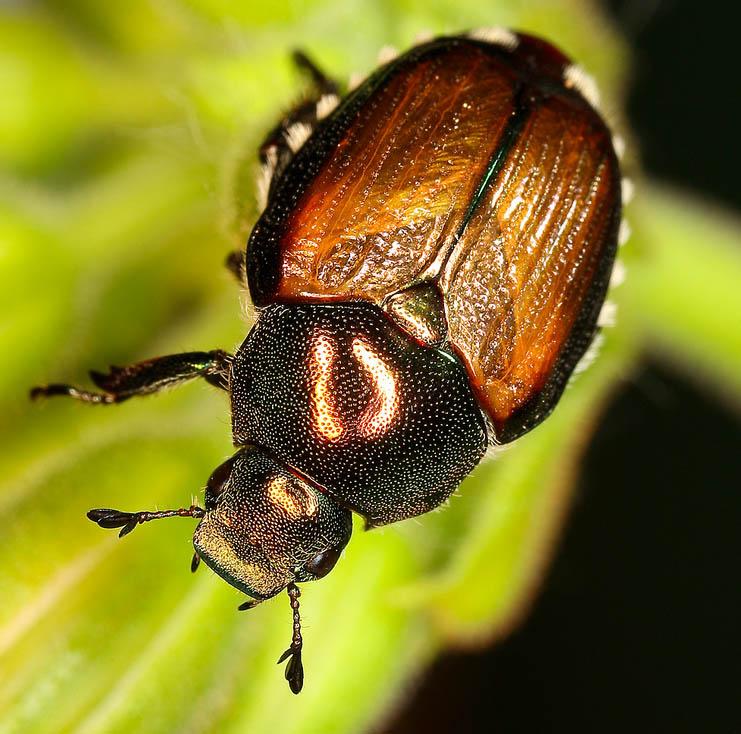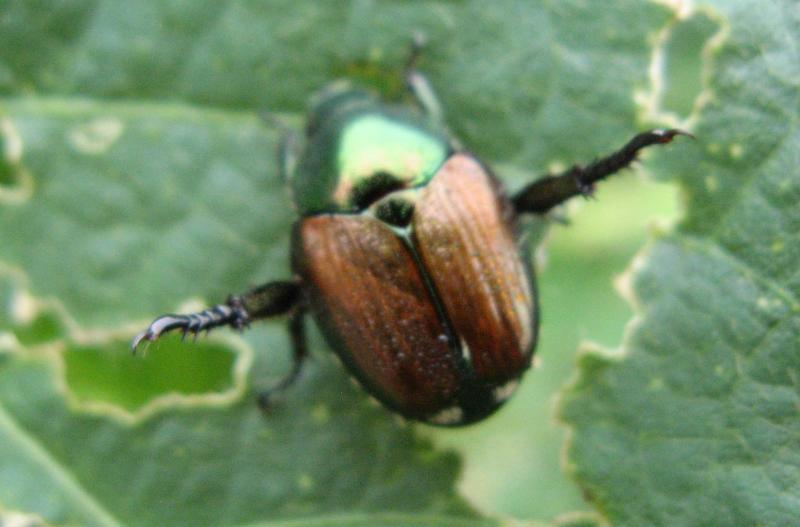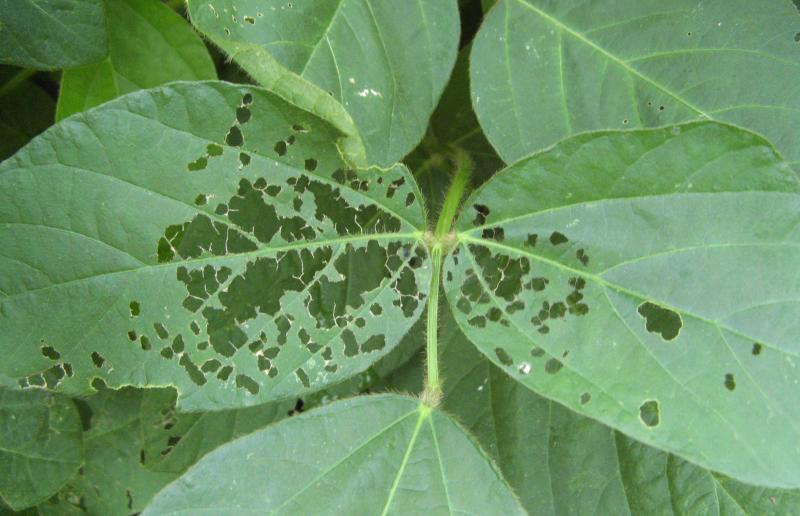
Written by Mary Roduner, former SDSU Extension Consumer Horticulture Field Specialist.
Japanese beetles (Popillia japonica) are pest beetles that came from Japan around 1916, damaging many crop and ornamental plants. They have been serious pests in the Eastern US for many years and have now moved into South Dakota the last few years.
The South Dakota Department of Ag with the help of SDSU Extension and the SD Master Gardeners has been trapping the beetles to determine where they are in the state. Additionally they are looking at if and how fast the beetles are spreading throughout the state.
Profile & Behavior

Japanese beetles have a distinctive appearance with a metallic green thorax, bronze red wing covers and white tufts of “hair” on the sides of their abdomen. They frequently rest with hind legs held out like oars on a paddle boat. In an average year, adults emerge from the soil in late June to early July. When the Growing Degree Day (GDD) numbers reach about 1000 the beetles are ready to emerge. GDD numbers are a cumulative measure of temperature used by farmers and other growers to help predict pest emergence or crop maturity.
While larvae, which are white grubs, do not do a large amount of damage in lawns compared to other white grubs, the adult life stage does the most damage. Adults like to feed in groups and give off a pheromone called an aggregate pheromone. This lets other beetles know where a good food supply is. They are good flyers and will smell food sources up to a mile away.
Damage to Plants

Adult beetles feed on leaves giving them a lacey appearance. Damaging the leaf surface by eating the tissue between leaf veins reduces the amount of food the plant can produce by photosynthesis, reducing vigor and ultimately killing the plants. Larvae feed on grass roots in sod.
Beetles feed on trees, ornamental plants and food crops. Their favorite foods are soybeans and any other form of bean. Traditionally they are known for feeding on roses of all types. The following lists show some of the plants that beetles feed on.
Plant Varieties at Risk
Woody Plants
- Norway maple
- Apple
- Crabapple
- Virginia creeper
- Plum, apricot, cherry, peach American mountain-ash
- Linden (American, European) Birch
- Black walnut
Ornamentals, Fruits, Vegetables
- Soybean
- Rose
- Grape
- Hollyhock
- Dahlia
- Sweet corn
- Sunflower
- Morning-glory
- Peony
- Asparagus
- Rhubarb
- Red raspberry
- Zinnia
- Queen Anne’s lace
Management Strategies

There are several control methods available for adult beetles. The beetles are sluggish on cool early mornings and can be easily hand-picked into a container of soap and salt water. If a chemical control is needed, carbaryl, orthene, and Malathion are the best choices. Be sure to follow label directions and apply only when bees and other beneficial insects are not active. Proper timing of grub control has not been determined yet for South Dakota.
Green and yellow traps can be also found in many areas of the state, especially where the Beetles were trapped in 2012 and 2013. The traps have lures that attract both males and females who fall inside and are unable to crawl out.
Safe Plant Varieties
You can prevent beetle damage by planting trees and ornamental plants they avoid. The following charts list some varieties Japanese beetles do not like to eat.
Woody Plants
- Boxwood
- Hickory
- Dogwood
- Burning-bush
- Forsythia
- Ash
- Juniper
- Spruce
- Pine
- Northern red oak
- Lilac
- Yew
- Arborvitae
Ornamentals
- Ageratum
- Columbine
- Dusty-miller
- Begonia
- Lily-of-the-valley
- Coreopsis
- Larkspur
- Foxglove
- Coral-bells
- Hosta
- Impatiens
- Lantana
- Moss-rose
- Showy sedum
- Nasturtium
- Violet, pansy


